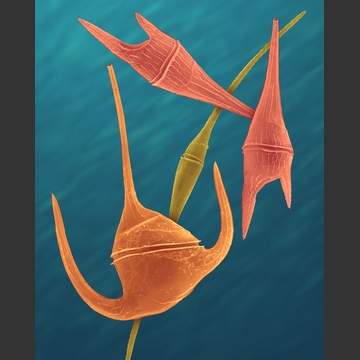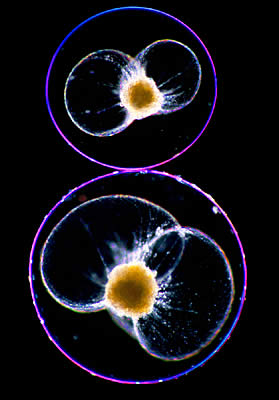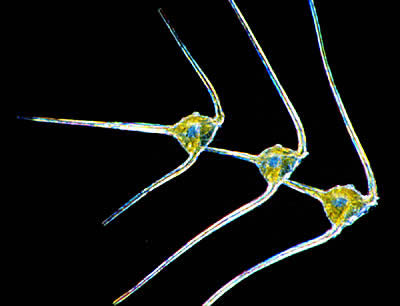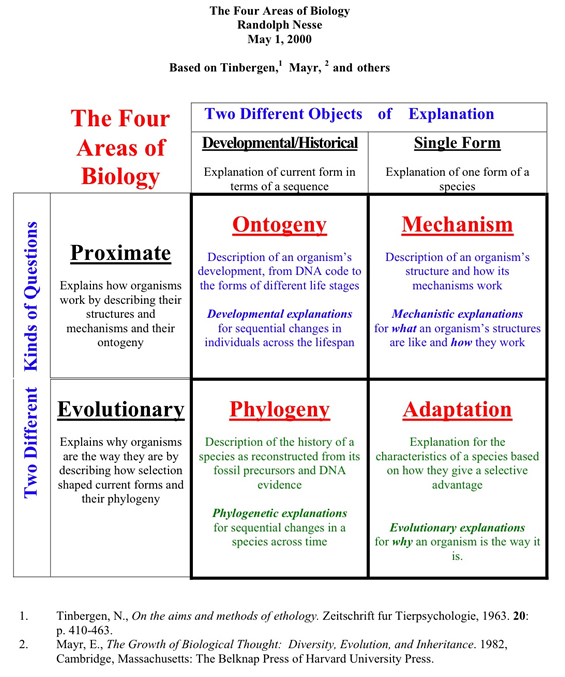Bioluminescence in Dinoflagellates
Biology 342 Fall 2010
Caitlin Miller and Madeline Dansky
Dinoflagellates
Bioluminescent Behavior

Bioluminescence
Bioluminescence is a phenomenon in which an organism produces and emits light. This ability can be seen in wide range of disparate organisms, the most common example being the firefly. Our focus is on the bioluminescent behavior of dinoflagellates. Dinoflagellates are sometimes called “Pyrrhophyta," meaning ‘fire plants’ because of some species’ ability to chemically produce light (5).
Dinoflagellate species are morphologically diverse and come in an assortment of complex forms, including various intricate organelles. One such complex organelle is called a scintillon, found in 18 genera of Dinoflagellates and is central to the reaction causing light emission. The reaction occurs when the substrate luciferin is broken down (oxidized) by the enzyme luciferase. The emission of light from an individual cell is quite short (about 0.1 sec) and light is produced typically by mechanical disruption, such as the crashing of waves on a shore (6). Marine bioluminescence is understood to be the primarily produced by dinoflagellates. This phenomenon is often characterized by fantastic displays of blue-glowing waves crashing on the sand.
image courtesy: Dennis Kunkel,"Marine Dinoflagellates" (13)
While the mechanism for producing light in dinoflagellates is fairly wellunderstood, there are many enduring questions pertaining to the evolutionary lineages of the organisms, the extent of their diversity in aquatic environments, and the adaptive value for bioluminescent behavior present in several dinoflagellate species.
Dinoflagellates
Dinoflagellates are unicellular eukaryotes that inhabit an array of aquatic environments. The greater majority of dinoflagellates are found in marine ecosystems, while a number of species are also found in freshwater systems. Roughly half of the species are photosynthetic and the other half heterotrophic. Dinoflagellate species accordingly make up a substantial portion of both phytoplankton and zooplankton populations (6).
Dinoflagellates are perhaps most prominently known for causing “red tides,” the expansive algal blooms which, when they occur, and can be devastating to the marine aquatic life in the area. The population densities of these blooms can jump to “more than 20 million per liter” along an affected coast (5). Dinoflagellates however also play a principal role in nutrient regeneration in marine environments; autotrophic phytoplankton are important primary producers and heterotrophic plankton “release nutrients stored in biomass during grazing of microbial organisms” (1).
Image Right: Dinoflagellate Pyrocystis, a bioluminescent dinoflagellate known as a seasparkle (15)
Left Image: Ceratium-dinoflagellates, the large projections of cells serve as protection against predators (15)


Image Courtesy (for above images): Peter Parks © 2001, Beyond the Reef (15)
Bioluminescent behavior in dinoflagellates will be explored through the spyglass of Tinbergens Four Questions:

Image courtesy: Suzy Renn's B342 :Animal Behavior course website (18)